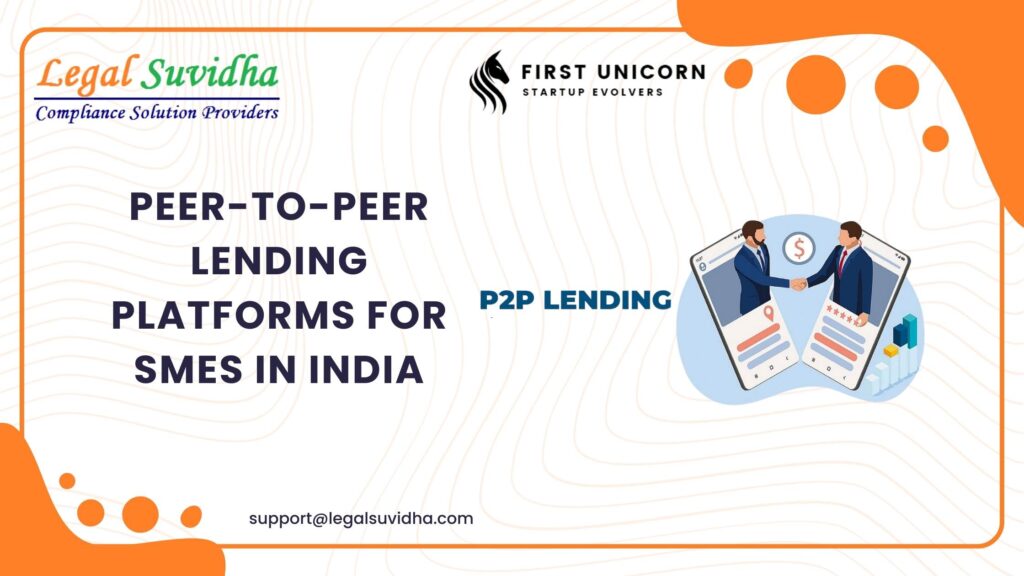Peer-to-Peer Lending Platforms for SMEs in India: A Game-Changer for Business Financing
1. Introduction to Peer-to-Peer Lending in India
India’s P2P lending industry has gained significant traction over the last few years. With the expanding startup ecosystem, many SMEs are turning to these platforms for financial support. According to a 2019 report by the Reserve Bank of India (RBI), the Indian P2P lending market has seen an exponential growth rate of 70% annually.
Today, India has multiple RBI-regulated P2P lending platforms, facilitating billions of rupees in loans to small businesses. The rise of digital transformation and increasing access to technology has made these platforms a viable option for SMEs often underserved by banks.
2. What is Peer-to-Peer Lending?
Peer-to-peer lending, often known as P2P lending, is a financial model that connects borrowers (SMEs) directly to lenders (individual investors) via an online platform. This process eliminates intermediaries, offering quicker, more efficient, and less expensive ways to secure funding.
- SMEs list their loan requirements on a P2P platform.
- Individual lenders evaluate applications and decide if they want to fund the loan.
- Borrowers receive funds directly from lenders, and repayments are made through the platform.
3. How Peer-to-Peer Lending Platforms Benefit SMEs
- Quick and Easy Access to Funds: Fast loan disbursement, often in 24-48 hours.
- Lower Interest Rates: Generally more competitive than banks due to fewer intermediaries.
- No Collateral Required: Many platforms offer unsecured loans.
- Flexible Loan Terms: Customized repayment terms based on business needs.
- Minimal Documentation: KYC and basic financial details are usually sufficient.
4. The Role of P2P Lending Platforms in India
The market has grown steadily due to RBI regulations introduced in 2017, enhancing transparency and credibility.
- Regulatory Framework: RBI ensures compliance and transparency.
- Prominent Platforms: Examples include Lendbox, Faircent, RupeeCircle, and CashCare.
5. Benefits of Peer-to-Peer Lending for SMEs
P2P lending offers immense benefits for SMEs:
- Unsecured loans without risking assets.
- Flexible repayment plans tailored to cash flow.
- Lower interest rates compared to traditional financing.
- Faster access to funds to seize business opportunities.
6. Risks and Challenges in Peer-to-Peer Lending for SMEs
- Credit Risk: Possibility of borrower default.
- Higher Rates for Riskier Borrowers: SMEs with lower creditworthiness may pay higher interest rates.
- Regulatory Uncertainty: The evolving market could face changes in laws and policies.
7. How SMEs Can Apply for Loans via P2P Lending Platforms in India
- Choose an RBI-compliant platform.
- Register and submit KYC and business details.
- Submit a loan request detailing the purpose and terms.
- Undergo loan evaluation by the platform and lenders.
- Receive funds and adhere to repayment terms.
8. Factors to Consider When Choosing a Peer-to-Peer Lending Platform
- Compare interest rates and fees.
- Evaluate loan terms for flexibility.
- Ensure RBI compliance.
- Research platform reviews and reputation.
9. Case Studies: Successful Use of Peer-to-Peer Lending by Indian SMEs
Examples of successful use cases:
- A manufacturing SME raised funds for raw materials, boosting production by 30%.
- An e-commerce startup scaled operations and hired staff using P2P funding.
- A logistics company invested in new trucks, expanding service areas and improving delivery times.
10. The Future of Peer-to-Peer Lending in India
The future holds promise with growth in digital financing, government support, and potential cross-border lending.
11. Conclusion: Why SMEs Should Consider P2P Lending for Financing
P2P lending is a fantastic alternative for SMEs to access quick, affordable, and flexible funding, empowering them to scale operations and innovate.
12. Frequently Asked Questions (FAQs)
- What is the minimum loan amount SMEs can apply for?
- Typically ranges from ₹50,000 to ₹10 lakh.
- Can SMEs get loans without collateral?
- Yes, many platforms offer unsecured loans.
- How are SMEs assessed for creditworthiness?
- Based on financial history, business plans, and credit scores.








